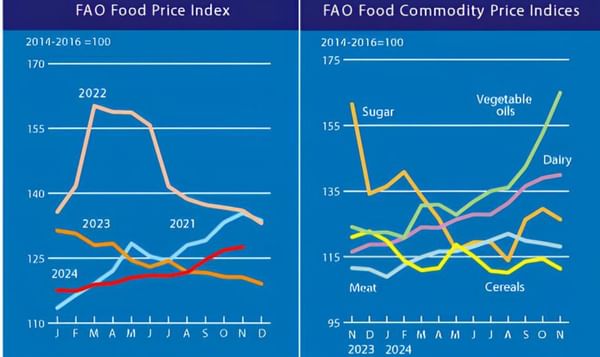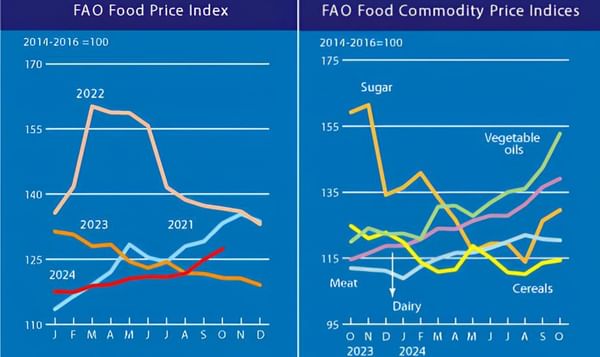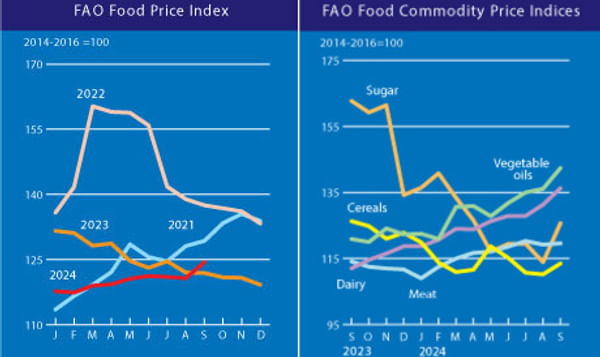The FAO Food Price Index (FFPI) averaged 169.8 points in December 2017, down 5.8 points (3.3 percent) from November with the steepest declines registered in the prices of dairy, vegetable oils and sugar while those of cereals and meat also fell but only slightly.
The FAO Food Price Index rebounded in 2017 despite a decline in December

The FAO Food Price Index (FFPI) averaged 169.8 points in December 2017, down 5.8 points (3.3 percent) from November with the steepest declines registered in the prices of dairy, vegetable oils and sugar while those of cereals and meat also fell but only slightly.
For the whole of 2017, the FFPI averaged 174.6 points, up 8.2 percent from 2016 and representing the highest annual average since 2014 although still 24 percent below the 2011 high of almost 230 points. While sugar values plummeted in 2017, dairy and meat prices registered sharp year-on-year increases and those of cereals and oils rose too, albeit more modestly.
The FAO Cereal Price Index averaged 152.7 points in December, down marginally from November but still up 7.4 percent from December 2016. Ample supplies and slower sales contributed to weaker wheat prices. However, international maize prices firmed slightly, mostly reflecting weather concerns in Argentina, while those of rice also inched up further, amid continued firm demand and currency appreciations in some leading exporting countries. Over the year, the FAO Cereal Price Index averaged 151.6 points in 2017, up 3.2 percent from 2016 but still some 37 percent below its peak reached in 2011.
The FAO Vegetable Oil Price Index averaged 162.6 points in December, down 9.6 points (5.6 percent) from November, marking a 5-month low. The drop mainly reflects lower quotations for palm, rapeseed and soybean oils. International palm oil prices tumbled, as stocks in Malaysia and Indonesia swelled to two-year highs on the back of relatively strong production and weak export demand. As to rape oil, upward revisions of crops in Canada and Australia weighed on prices, whereas soy oil quotations were pressured by rival palm oil. For the year as a whole, the FAO Vegetable Oil Price Index averaged nearly 169 points, up 3 percent from 2016 but still well below the peaks recorded in 2008 and 2011.
The FAO Meat Price Index averaged 171.6 points in December, marginally below its slightly revised value of November. International price quotations for bovine meat fell, pressured by increased offerings in both domestic and international markets. However, pig, poultry and ovine meat quotations changed only little, reflecting an overall balanced supply and demand situation. For the year, the FAO Meat Price Index averaged 170 points in 2017, up 9 percent from 2016 but 4.7 percent below the average for the preceding five years (2012-2016). In 2017, ovine meat prices recorded the largest increase, followed by those of pigmeat, poultry and bovine meat.
The FAO Dairy Price Index averaged 184.4 points in December, down 19.8 points (9.7 percent) from November, marking the third successive month of decline. High export supplies in the face of subdued demand weighed on the international prices of all the four milk products that constitute the Index. Uncertainty over the intervention stocks in the EU continued to put downward pressure on international price quotations for skim milk powder (SMP). Overall, the FAO Dairy Price Index averaged 202.2 points in 2017, up 31.5 percent from 2016, with the largest increase recorded for butter followed by whole milk powder (WMP) and cheese, whereas SMP prices remained stable.
The FAO Sugar Price Index averaged 204 points in December, down 8.6 points (4.1 percent) from November. After a relatively strong rebound in November, international sugar quotations fell back in December due to seasonal pressure, subdued demand and expectations of a large surplus in 2018. Over the year, the FAO Sugar Price Index averaged 227.3 points in 2017, down 11.2 percent from 2016 and as much as 38 percent from its 2011 peak of 369 points. The fall in sugar prices in 2017 largely reflected a bumper harvest in Brazil, the world’s largest producer, along with strong production recoveries in India and Thailand.
For the whole of 2017, the FFPI averaged 174.6 points, up 8.2 percent from 2016 and representing the highest annual average since 2014 although still 24 percent below the 2011 high of almost 230 points. While sugar values plummeted in 2017, dairy and meat prices registered sharp year-on-year increases and those of cereals and oils rose too, albeit more modestly.
The FAO Cereal Price Index averaged 152.7 points in December, down marginally from November but still up 7.4 percent from December 2016. Ample supplies and slower sales contributed to weaker wheat prices. However, international maize prices firmed slightly, mostly reflecting weather concerns in Argentina, while those of rice also inched up further, amid continued firm demand and currency appreciations in some leading exporting countries. Over the year, the FAO Cereal Price Index averaged 151.6 points in 2017, up 3.2 percent from 2016 but still some 37 percent below its peak reached in 2011.
The FAO Vegetable Oil Price Index averaged 162.6 points in December, down 9.6 points (5.6 percent) from November, marking a 5-month low. The drop mainly reflects lower quotations for palm, rapeseed and soybean oils. International palm oil prices tumbled, as stocks in Malaysia and Indonesia swelled to two-year highs on the back of relatively strong production and weak export demand. As to rape oil, upward revisions of crops in Canada and Australia weighed on prices, whereas soy oil quotations were pressured by rival palm oil. For the year as a whole, the FAO Vegetable Oil Price Index averaged nearly 169 points, up 3 percent from 2016 but still well below the peaks recorded in 2008 and 2011.
The FAO Meat Price Index averaged 171.6 points in December, marginally below its slightly revised value of November. International price quotations for bovine meat fell, pressured by increased offerings in both domestic and international markets. However, pig, poultry and ovine meat quotations changed only little, reflecting an overall balanced supply and demand situation. For the year, the FAO Meat Price Index averaged 170 points in 2017, up 9 percent from 2016 but 4.7 percent below the average for the preceding five years (2012-2016). In 2017, ovine meat prices recorded the largest increase, followed by those of pigmeat, poultry and bovine meat.
The FAO Dairy Price Index averaged 184.4 points in December, down 19.8 points (9.7 percent) from November, marking the third successive month of decline. High export supplies in the face of subdued demand weighed on the international prices of all the four milk products that constitute the Index. Uncertainty over the intervention stocks in the EU continued to put downward pressure on international price quotations for skim milk powder (SMP). Overall, the FAO Dairy Price Index averaged 202.2 points in 2017, up 31.5 percent from 2016, with the largest increase recorded for butter followed by whole milk powder (WMP) and cheese, whereas SMP prices remained stable.
The FAO Sugar Price Index averaged 204 points in December, down 8.6 points (4.1 percent) from November. After a relatively strong rebound in November, international sugar quotations fell back in December due to seasonal pressure, subdued demand and expectations of a large surplus in 2018. Over the year, the FAO Sugar Price Index averaged 227.3 points in 2017, down 11.2 percent from 2016 and as much as 38 percent from its 2011 peak of 369 points. The fall in sugar prices in 2017 largely reflected a bumper harvest in Brazil, the world’s largest producer, along with strong production recoveries in India and Thailand.
Like to receive news like this by email? Join and Subscribe!
Join Our Telegram Channel for regular updates!
精选企业
Sponsored Content
Sponsored Content
Sponsored Content
Sponsored Content
Sponsored Content











